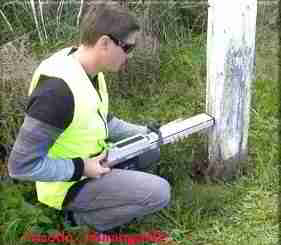 Procedure for using Micro Drilling for Structural Wood Timber or Beam Damage Assessment
Procedure for using Micro Drilling for Structural Wood Timber or Beam Damage Assessment
How to assess the structural integrity of wood framing or wood timbers in-situ using micro-drilling
- POST a QUESTION or COMMENT about methods used in testing structural wood members for damage or decay & the role of micro-drilling tests for in-situ evaluation of structural wood beams, timbers, or other framing members in buildings..
Micro-drilling procedure details used for determining the soundness of wood structural members:
Micro-drilling wood damage testing involves drilling a 2 mm hole in timber members up to 300mm. Drill resistance and related data are processed by computer to provide a graph of wood density and other properties. This article series also compares using micro-drilling with other methods to screen both standing trees and wood structural elements for hidden damage. scribe the relationship between construction details and the occurrence of structural rot in timber frame buildings.
This article series describes the various methods used to test & evaluate the structural integrity of wood-framed buildings where focus is on the condition of structural wood posts, beams and other framing members. We discuss the problems surrounding hidden rot or decay, the presence or absence of moisture or other instrument-detectable clues, and the problem of subjective decisions to replace or not-replace suspect wood structural members.
InspectAPedia tolerates no conflicts of interest. We have no relationship with advertisers, products, or services discussed at this website.
- Daniel Friedman, Publisher/Editor/Author - See WHO ARE WE?
How does Micro Drilling Timber Assessment Work?
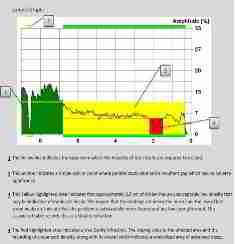 Paul Probett, Clinton Craig, Blake Probett, Incodo Forensic Building Specialists [1]
Paul Probett, Clinton Craig, Blake Probett, Incodo Forensic Building Specialists [1]
This article series on methods for assessing structural wood rot & damage is adapted & expanded from the author's "An Introduction to Micro-Drilling Technology for N. Z. Structural Timber Assessment" and is used with permission. We [DF] have added comments, some illustrations, and additional article citations.
At the references section we include a link to the original article as well as contact information for the authors and Incodo Ltd., a Tauranga, New Zealand forensic engineering firm.
[Click to enlarge any image or illustration]
Our discussion of micro-drilling is divided into three segments. Below is segment 2.
- WOOD BEAM MICRO-DRILLING ASSESSMENT - - Incodo study of microdrilling for wood structure assessment
- WOOD BEAM MICRO-DRILLING PROCEDURES - separate article, details of how micro drilling is used to assess wood structural member condition
- WOOD BEAM MICRO-DRILLING EFFECTIVENESS - separate article, Micro-Drilling: Resistance drill Methods for Wood Structural Member Assessment. Incodo Testing Program of Micro-Drilling for Wood Assessment
Procedure for Using Micro Drilling for Timber Damage Assessment
 Testing involves drilling a 2 mm hole in timber members up to 300mm
Testing involves drilling a 2 mm hole in timber members up to 300mm
The drill is computer controlled with drill bit rotation rpms and linear penetration independent of each other and at pre-set levels applicable to the timber species. This is a change from older generation microdrills that had rpm and penetration linked and power applied controlled by the operator.
Results are readable in real time via the onboard display as the graph is formed.
Typical testing for 100 mm p.rad framing is about 15 seconds.
Results are also processed according to developed timber specie parameters and appropriate standards (where applicable) so onboard software instantly gives a preliminary pass, fail or retest assessment of timber. Settings are adjustable to assist with the identifying of quality infractions, decay areas and splits or checks.

Information is then bluetoothed to a draft report and presented in a similar format to the following graphs and charts.

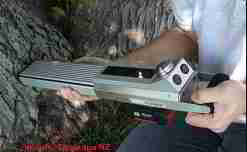

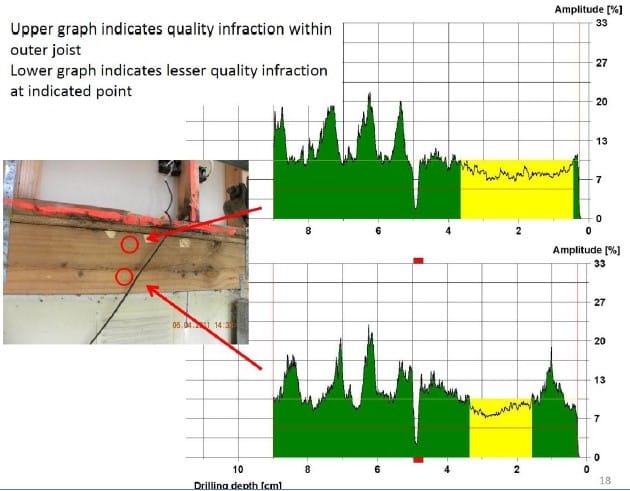

As highlighted in the 2010 RILEM State of the Art Report – In Situ Assessment of Structural Timber by Kasal and Tannert “ If strength values are require(d) the best drills available on the market are required as well as a high level of education and experience. This, proper education of the user is a critical point before applying resistance drilling” quote
Incodo endorse the above and suggest general usage, adjusting
programmable settings interpretation and moderation of results is critical.
Micro-drilling In Situ Timber assessment
Test Results: Summary
- Base of studs where decay transmitted from wet bottom plate – timber frequently found to be sound within 150 - 200 mm possibly allowing splinting of studs rather than full replacement
- Double timbers joists and studs – frequently decay between members but sound outer faces.
- Some surface decay has limited penetration
- External corner studs behind direct fix cladding can have stepped clamping point decay
Test Results: Evaluation and Moderation
Test results indicate appreciable differences between sound and unsound timber. Noticeable anomalies on graphs indicative of issues include:
- Partial or Full loss of all or some latewood peaks.
- Smoothing of graphs along upper amplitude line affecting normal early wood and latewood norms (lower height of “saw teeth”).
- Significant variation across a graph in different area.
- General lowering of results in areas on same graph.
- Sloping shoulders as graph drops to plateau or valley.
- Sloping shoulder to graph at entry and exit points rather than near vertical step within 2-3mm of surfaces.
- Acceptable anomalies which are readily identifiable include changes induced by splits, checks, knots, junction between two timber members and pithy cores.
While software is set to handle many of these factors, moderation of individual graphs is part of the testing process and recommendations are that all reports are moderated before being provided.
Micro-drilling Wood Structure Test Protocols
Recommended testing involves checking bottom plates at 1.0m centres and as close as practicable to external corners. In addition testing focuses on high risk details such as window sill corners and points below, balcony to wall connections, base of apron flashings etc and wherever staining or other concern aspects are noted.
Inspection locations are plotted on a WIN 7 tablet using preloaded plans or elevations or on photos taken using the tablet’s main camera. Incodo have developed a suitable template for wirelessly transmitting data from the drill into an open report which can be prepared on the tablet or sent to the office for moderation and review.
Reports are comprehensive and targeted completion for reports is the same or following day after inspection.
Micro-drilling methodology testing for NZ timbers- A Basis
INCODO has undertaken substantial in-house testing to determine suitability of micro-drilling for assessment of low density plantation grown pinus radiata in particular.
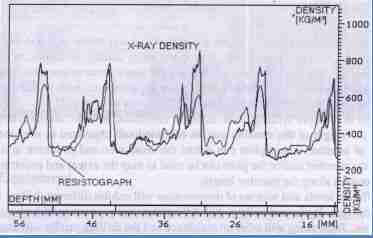 Graph highlighting close correlations between X-ray density and resistance drill readings taken using a Resistograph micro-drill.
Graph highlighting close correlations between X-ray density and resistance drill readings taken using a Resistograph micro-drill.
Quoting:
Profiles of radial X-ray density and drill resistance of the same larch sample.
Rilem - State of the Art Report In Situ Assessment of Structural Timber, Bohumil Kasal & Thomas Tannert, Springer 2010. [3][4][5][6]
In addition reliance has been based on studies by others* involving micro-drilling in Europe, USA and Australia related to structural timber in buildings and bridges.
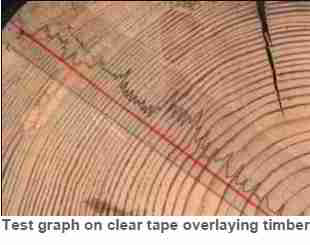 The technology has been used for many years. The big difference is that the PD model is a new generation micro-drill with onboard firmware
The technology has been used for many years. The big difference is that the PD model is a new generation micro-drill with onboard firmware
*Ref www.printfu.org search “Resistograph” or “Sibtec”
Quote
“Wood density is the property which will be used as an example because of its’ close correlation with timber strength (Dadswell and Nicholls, 1959, Elliot 1970) …and because it is widely held by wood technologists to be the single most important wood variable (de Zeeuw 1965) According to Panshin et al (1963) the relationship between wood density and timber strength is expressed by
S = K (D)n
Where S is any of the strength properties, K is a constant, D is density and n is an exponent which depends on the strength property being considered”
- WOOD DENSITY OF RADIATA PINE: ITS VARIATION AND MANIPULATION – D J Cown, FRI
Note: Above information is copyright, commercially sensitive and is yet to be peer reviewed. It is not to be copied or circulated without the express and written permission of Incodo Limited. Adapted here by InspectaPedia.com, with permission from Incodo 8/5/2012, technical review is in process.
V4a 06/12 - ####
The original authors' article without the expanded discussion added here can be seen at An Introduction to Micro-Drilling Technology for N. Z. Structural Timber Assessment. [PDF]
Additional comments, illustrations, and technical citations addressing wood structure testing technologies have been added. We and the original authors invite and will reply to reader questions and comments using the comments box found at the end of this article. Initial technical review completed 8/6/201
...
Continue reading at WOOD BEAM MICRO-DRILLING EFFECTIVENESS or select a topic from the closely-related articles below, or see the complete ARTICLE INDEX.
Or see these
Wood Structure Testing Articles
- WOOD STRUCTURE ASSESSMENT - home
- CRACKS CHECKS SPLITS in BEAMS, LOGS & POSTS
- INSECT INFESTATION / DAMAGE - home
- INSECT DAMAGE PREVENTION
- MERULIPORIA FUNGUS DAMAGE
- ROT, TIMBER FRAME
- ROT TYPES, BROWN SOFT WHITE
- ROT, TIMBER ASSESSMENT
- SPLITS & CRACKS in STRUCTURAL WOOD BEAMS
- STRUCTURAL DAMAGE PROBING
- TABLE of TREE DECAY DETECTION EQUIPMENT
- WOOD BEAM VISUAL INSPECTION
- WOOD BEAM MICROBIOLOGICAL ASSESSMENT
- WOOD BEAM FRACTOMETER TESTING
- WOOD BEAM PILODYN TESTING
- WOOD BEAM MICRO-DRILLING ASSESSMENT
- WOOD BEAM MICRO-DRILLING PROCEDURES
- WOOD BEAM MICRO-DRILLING EFFECTIVENESS
- WOOD BEAM ROT ASSESS: MOISTURE METERS
- WOOD BEAM ROT ASSESS: THERMOGRAPHY
Suggested citation for this web page
WOOD BEAM MICRO-DRILLING PROCEDURES at InspectApedia.com - online encyclopedia of building & environmental inspection, testing, diagnosis, repair, & problem prevention advice.
Or see this
INDEX to RELATED ARTICLES: ARTICLE INDEX to BUILDING STRUCTURES
Or use the SEARCH BOX found below to Ask a Question or Search InspectApedia
Ask a Question or Search InspectApedia
Try the search box just below, or if you prefer, post a question or comment in the Comments box below and we will respond promptly.
Search the InspectApedia website
Note: appearance of your Comment below may be delayed: if your comment contains an image, photograph, web link, or text that looks to the software as if it might be a web link, your posting will appear after it has been approved by a moderator. Apologies for the delay.
Only one image can be added per comment but you can post as many comments, and therefore images, as you like.
You will not receive a notification when a response to your question has been posted.
Please bookmark this page to make it easy for you to check back for our response.
IF above you see "Comment Form is loading comments..." then COMMENT BOX - countable.ca / bawkbox.com IS NOT WORKING.
In any case you are welcome to send an email directly to us at InspectApedia.com at editor@inspectApedia.com
We'll reply to you directly. Please help us help you by noting, in your email, the URL of the InspectApedia page where you wanted to comment.
Citations & References
In addition to any citations in the article above, a full list is available on request.
- [1] Paul Probett, Clinton Craig, Blake Probett, "An Introduction to Micro-Drilling Technology for N. Z. Structural Timber Assessment", Incodo Ltd, 4/511 Cameron Rd, Tauranga NZ, article adapted by InspectAPedia with permission, August 2012. Contact the authors by Email: Paul Probett, mail2us@incodo.co.nz , Tel: 027 28 000 36 (Mobile) Website: https://www.incodo.co.nz/ [Copy of this article on file as Microdrilling_Assessment_Incodo.pdf]
Quoting from the Incodo website the company describes its services:- Incodo Forensic Building Pathology:
The Forensic Building Pathology division provides evidence in report form to government agencies, consultancy firms, lawyers and others, when truly independent analysis based on comprehensive testing is required. Incodo arguably has the largest, most up-to-date and comprehensive range of building investigation equipment available and has developed unique methodologies particularly in the field of non-destructive testing for leaking structures. - Incodo In situ Timber Assessment:
The in-situ Timber Assessment division provides a service whereby technicians use state-of-the-art timber resistance drill technology to profile variations in timber density associated with timber decay.
The work is done on site and the results are instant.
This technology is objective and evidential in nature and provides assessment as to whether wood is significantly decayed, suspect or suitable for retention. The technology has particular application in locating and assessing hidden decay.
- Incodo Forensic Building Pathology:
- [2] Thomas Tannert, Andreas Muller, Mareike Vogel, "Applications and limitations of NDT: a timber bridge case study", NDTCE’09, Non-Destructive Testing in Civil Engineering
Nantes, France, June 30th – July 3rd, 2009, web search 8/3/2012, original source: http://www.ndt.net/article/ndtce2009/papers/144.pdf [copy on file as Tannert_Timber_Test_144.pdf]
Abstract
The applications and limitations of different non-destructive and semi-destructive techniques to evaluate the structural integrity of timber members in a pedestrian bridge are presented as a case study. Sophisticated assessment tools are required to detect hidden damages in timber structures: for example stress-wave techniques are used to evaluate the modulus of elasticity of bending members and resistance to drilling is used to gain knowledge of areas of changed density due to insect or moisture induced damages. Reliably relating the gathered data to the structural integrity of the structure is a complex issue. Bending members and connection details of a decommissioned timber bridge were evaluated using non destructive assessment tools. Eventually these parts were tested destructively to assess their remaining modulus of elasticity and load bearing capacity. The need for improvements in the current practice is highlighted by comparing the results from the non-destructive, semidestructive and destructive tests. - [3] Bohumil Kasal, Thomas Tannert, "RILEM Technical Committee on In Situ Assessment of Structural Timber", Bohumil Kasal et al., 2010, Advanced Materials Research, 133-134, 271, Abstract: Timber is an intriguing structural material and the only one that is truly renewable. Being biodegradable, hygroscopic and non-isotropic, it presents special challenges when assessing its integrity in structures. The presented paper outlines the major issues related to in-situ evaluation of structural timber and summarizes the work of the RILEM Technical Committee 215-AST “In-situ assessment of structural timber”. The committee was established in 2005 to bring together leading scientists and practitioners in the field of evaluation of timber in existing structures. Timber structures have been investigated for decades using numerous techniques that have been either developed specifically for the material or were transferred from other fields of investigation. A state-of-the-art report describing existing and emerging technologies and methods was prepared by the RILEM committee. The report describes the principles, the applications and the limitations of major evaluation techniques for in-situ assessment of timber. A brief discussion of codes standards and future research needs shows that much needs to be done in this area. As a present activity, harmonized test procedure recommendations are being prepared that will provide the engineering community with valuable guidance when evaluating timber structures.
- [4] Bohumil Kasal & Thomas Tannert (Editors), In Situ Assessment of Structural Timber, ISBN 978-94-007-0559-3, Rilem 2010
- [5] Bohumil Kasal, Tension Micro Specimens,
In Situ Assessment of Structural Timber
RILEM State of the Art Reports, 2011, Volume 7, 75-80, DOI: 10.1007/978-94-007-0560-9_8, [excepts chapter 7 on file: Tension Micro-Specimens, as Kasal_Testing.pdf]
Abstract The principle of this method is extracting triangular specimens (about 5 mm equal-sides triangle) along the length of the member. Small-kerf circular saw with a fixture attached to the surface of the member is used to extract the specimens. Specimens are then glued to the test blocks and tested in tension. The method gives direct values of tensile modulus of elasticity and strength for clear wood. The values are local and pertain to the tested area and surface.
[From chapter 7.1 Background: This method was developed by Kasal and is based on direct measurement of tension properties along fibers. Bending strength evaluation is an important aspect of in situ evaluation of timber members as it is one of the predominant modes of loading, but estimates of the bending properties in situ can present a challenge. With information on the member's tensile properties, bending strength estimates can be made; tensile strength has been related to bending strength and is considered to be approximately equal. Tensile properties have a poor correlation with compression properties therefore tensile strength can not be estimated using information attained with the core drilling technique. Specimens can however be extracted to evaluate the tensile properties of in situ members with the technique described in the following sections....'] - [Also] Kasal B, Anthony R: Advances in in-situ evaluation of timber structures. Progress in Structural Eng and Materials. 6(2):94-103, 2004.
- [6] Thomas Tannert, Andreas Müller, Mareike Vogel, "in-situ assessment, hot spots, moisture content, block-laminated timber", ICTB 2010, Bern University of Applied Sciences. ISBN 978 8251 926805, in-situ assessment, hot spots, moisture content, block laminated timber,
Abstract:
Timber has been a structural material for bridges for centuries and numerous examples throughout the world demonstrate its durability. But timber is biodegradable and hygroscopic and regular inspections are recommended to determine the condition of the structure. This paper reports on the structural health monitoring of timber bridges in general and the long term moisture measurement inside block-laminated timber elements of several traffic bridges in specific. Presently there is no reported scientific information available on the long-term moisture behaviour and the resulting moisture induced stresses and dimensional changes of block-laminated timber elements. The paper reports on the monitoring of the moisture content of a block-laminated timber bridge.
[References 7-13 below are cited from this document] - [7] Wilkinson K, Thambiratnam D, Ferreira L. Non Destructive Testing of Timber Bridge Girders. In Proceedings Int. Conf. on Structural Condition Assessment, Monitoring and Improvement, Perth, Australia, 2005.
- [8] Kasal B, Anthony R: Advances in in-situ evaluation of timber structures. Progress in Structural Eng and Materials. 6(2):94-103, 2004.
- [9] Gerold M. Bloc-Glued Laminated decks for timber bridges. Structural engineering international, 12(3): 214–217, 2002.
- [10] Graham T. Overview of non-destructive evaluation technologies. In Proceedings of the Nondestructive Evaluation of Aging Bridges and Highways, Ed by S. Chose, 1995.
- [11] Duwadi SR, Ritter MA. An Overview of the Wood in Transportation Program in the United States, In Proceedings 5th World Conference on Timber Engineering, Montreux, Switzerland, 1998.
- [12] Rinn F, Schweingruber FH, Schär E. Resistograph and X-Ray Density Charts of Wood. Comparative Evaluation of Drill resistance Profiles and X-Ray Density Charts of Different Wood Species. Holzforschung 50:303-311, 1996.
- [13] Brashaw B, Vatalaro RJ, Wacker JP and RJ Ross. Condition Assessment of Timber Bridges: 1. Evaluation of a Micro-Drilling Tool. Gen. Tech. Rep. FPL-GTR-159. Forest Products Laboratory Madison, WI. 2005.
- [14 Simpson W. Drying and Control of Moisture Content and Dimensional Changes. Chapter 12, Wood handbook - wood as an engineering material. General Technical Report FPL–GTR– 113. Forest Products Laboratory, WI, 1999.
- [15] "Fractometer Print Manual", IML Instrumenta Mechanik Labor System GmbH Großer Stadtacker 2 69168 Wiesloch • Germany, 02-2008, web search 8/4/12, original source: http://www.imlusa.com/Fractometer_Print_eng_web_A4.pdf [Copy on file as Fractometer_Print_eng.pdf]
- [16] Bob Monk, "Evaluation of Decay Detection Equipment in Standing Trees", USDA Forest Service, web search 8/4/12, original source http://www.fs.fed.us/eng/techdev/IM/tree_decay/tree_decay_detect_equip.shtml [Copy on file as Monk_Tree_Deday_Detection.pdf] Introduction - quoting:
A project was proposed to test and compare several of the devices that are able, to some degree, to detect decay in trees. Decay in trees is directly related to the hazards that they present. However, detection of decay does not necessarily mean that a tree is hazardous. The identified devices can be used to determine what decay is present. It is still necessary to use professional experience and sound judgment to decide if a tree actually poses a hazard. General guides or "rules of thumb" can also be used, such as Guidance notes from the Minnesota Department of Natural Resources and the USDA Forest Service, 1996 that suggests a 25 mm ring of sound wood is required for every 150 mm of stem diameter at any point on the stem. If the proportion of decayed wood to sound wood exceeds this level then action may need to be taken to minimize the hazard posed by the tree (Lawday and Hodges, 2000). [Additional selected citations from this article are below]- [16a] Larsson, B.; Bengtsson, B.; and Gustafsson, M. 2004. Nondestructive Detection of Decay in Living Trees. Tree Physiology. 24: 853-858
- [16b] Moore, W. 1999. The Combined Use of the Resistograph and the Shigometer for the Accurate Mapping and Diagnosis of the Internal Condition of woody Support Organs of Trees. Arboriculture Journal. 23: 273-287
- [16c] Nicolotti, G.; Socco, L.V.; Martinis, R.; Godio, A.; and Sambuelli, L. 2003. Application and Comparison of Three Tomographic Techniques for Detection of Decay in Trees. Journal of Arboriculture. 29(2): 66-77
- [16d] Seavey, R.; and Larson, T. 2002. Inspection of Timber Bridges. Minnesota Department of Transportation Technical Report MN/RC-2002-34. St. Paul, MN. 43 p.
- [16e] Wang, X.; Divos, F.; Pilon, C.; Brashaw, B.K.; Ross, R.J.; and Pellerin, R.F. 2004. Assessment of Decay in Standing Timber Using Stress Wave Timing Nondestructive Evaluation Tools: A Guide for Use and Interpretation. Gen. Tech. Rep. FPL-GTR-147. Madison, WI: U.S. Department of Agriculture, Forest Service, Forest Products Laboratory. 11 p.
- [17] Pilodyn Wood Tester, USA / Canadian Source: Intech-NDE, 6211 Roper Road
Edmonton, Alberta
T6B 3G6, Tel: 1 888-576-7756 or Intech-NDE, 140 - 8851 Beckwith Road
Richmond, B.C., Tel: 1 800-677-8884, or USA Tel: 800-297-3208, Website: http://www.intechnde.com, web search 8/4/12, original source: http://www.corvib.com/pilodyn/ Quoting:
Pilodyn is an easy-to-use wood testing instrument which is suitable for trees, railway ties and utility poles. The Pilodyn wood tester (Hylec Controls) is described by and currently available in North America from InTech/NDE U.S. Tel: 905-716-5604 / 800-297-3208, or Email: bnadeau@intechnde.com - [18] Pilodyn Wood Tester, Hylec Controls, available in Australia from Ferret http://www.ferret.com.au/n/Pilodyn-wood-density-meter-from-Hylec-n852069 - Quoting:
Pilodyn, available from Hylec Controls , was developed to determine the density and strength of dead and living wood. Invisible soft rot can be detected rapidly and objectively in an easy non-destructiveway and the reduction in strength associated with it can be determined. This can be of vital importance in the case of wooden playground structures,climbing frames and telephone masts.
With PILODYN 6J Forestversion the density of the wood is determined on living trees. The damage is so little that the tree suffers no harm and the testing method is regarded as non-destructive.
Testing procedure: The testing procedure is very simple: The tester is loaded with the ramrod and then pressed firmly onto the tet surface. The impact pin is shot into the wood by pressing the trigger cover. The depth of penetrationcan be read straightaway in mm on the scale mounted on the tester.
Typical applications of the Pilodon:
Testing the stability of wooden structures on playgrounds, detection of soft rot
Testing the strength on wooden telephone masts, detection of soft rot
When thinning out: sorting out trees with undesirable density of the wood
Early detection of diseases: periodic measurement detects unnatural changes in the wood density
Comparison of the location-dependent density to determine the optimal location for the respective tree species
Establishing productivity with respect to density for the same tree species and similar location properties for culture purposes Testing and sorting of cut wood into timber classes - [19] Hylec Controls, 8 Melissa Street AUBURN NSW 2144 AUSTRALIA, Tel: 1300 522 004, Email: sales@hyleccontrols.com.au, http://www.ferret.com.au/c/Hylec-Controls
- [20] Brashaw, Brian K.; Vatalaro, Robert J.; Wacker, James P.; Ross, Robert J. 2005. "Condition Assessment of Timber Bridges: 1. Evaluation of a Micro-Drilling Resistance Tool" Gen. Tech. Rep. FPL-GTR-159. Madison, WI: U.S. Department of Agriculture, Forest Service, Forest Products Laboratory. 8 p., web search 8/5/2012, original source: http://www.fpl.fs.fed.us/documnts/fplgtr/fpl_gtr159.pdf [copy on file as Micro_Drill_Study_USDA_fpl_gtr159.pdf] This publication is also available from the U.S. FPL at www.fpl.fs.fed.us
Abstract:
The research presented in this report was conducted to evaluate the accuracy and reliability of a commercially available micro-drilling resistance device, the IML RESI F300-S (Instrument Mechanic Labor, Inc., Kennesaw, Georgia), in locating deteriorated areas in timber bridge members. The device records drilling resistance as a function of drilling depth, which allows the operator to assess the location of deterioration in the member cross section. Bridge components containing different levels of natural decay were used as test specimens in this study. The IML RESI F300-S was first used to assess decay in the timber bridge specimens. The specimens were then sawn along their length into slabs to expose their interior condition. The interior faces of these slabs were inspected visually and with a stress-wave probe to confirm if deterioration was present. On the basis of these tests, we conclude that this micro-drilling device accurately determines if deterioration is present at the point at which the test is performed. Keywords: timber, bridges, inspection, drilling resistance, nondestructive evaluation
Excerpt from the study's conclusions:
Based on our tests, we offer the following comments about the accuracy of using the IML RESI F300-S for locating deterioration in bridge timbers:
1. The tool is accurate at determining the presence of decay in timber bridge specimens. However, these data are limited to the drilling location.
2. The tool can precisely locate an internal defect (decay pocket, check, or split) within the member’s cross section. This can be advantageous for condition assessment and load rating purposes.
3. Decay indices were developed for Douglas-fir timbers as follows: sound, >25% resistance; moderate decay, 10–25%; and advanced or severe decay, 0–10%.
One drawback is that multiple, time-consuming drilling would be required to map the area and extent of the decay in the other plane. Another possible drawback is the potential to spread the decay to sound areas within a timber or to sound timbers by multiple use of a contaminated drill bit. Routine cleaning of drill bits, or replacement with a new one, would greatly reduce this potential drawback.
It is crucial to use this or any nondestructive testing tool or device as part of a comprehensive condition assessment. Such an assessment should incorporate an in-depth visual inspection, knowledge of prior use of the structure, and a working knowledge of fundamental engineering properties of structural wood products. This technique, when used in concert with visual and ultrasound techniques, would provide a very accurate description of the condition of timbers. - [21] Brashaw, B.K.; Vatalaro, R.J.; Erickson, J.R.; Forsman, J.W.; Ross, R.J. 2004. Final Report: A Study of Technologies to Locate Decayed Timber Bridge Members. Project No. 187-6456, NRRI/TR-2004-06. Duluth, MN: UM-Duluth, Natural Resources Research Institute.
- [22] Brashaw, B.K.; Vatalaro, R.J.; Ross, R.J.; Wacker, J.P. 2005. Condition Assessment of Timber Bridges: 2. Evaluation of Several Commercially Available Stress Wave/Ultrasonic Tools. Gen. Tech. Rep. FPL-GTR-160. Madison, WI: USDA Forest Service, Forest Products Laboratory.
- [23] Ross, R.J.; Brashaw, B.K.; Wang, X.; White, R.H.; Pellerin, R.F. 2004. Wood and Timber Condition Assessment Manual Madison, WI: Forest Products Society. 74 p.
- [24] Troltech GMBH & Co. KG. Deutchland, Grebbener Str. 7, D-52525 Heinsberg, Deutchland, produces the Trotec T2000, Tel: 02452 962-450, International: +49 2452 962-450, Email: online@trotec.de, Website: http://www.trotec.de/, Web page for the Troltec T2000: http://www.trotec.de/en/product-catalog/measuring-instruments/multi-function/t2000/
- [25] Paul Probett, Incodo, Ltd., "Thermal Imaging and Building Surveying / Inspection" 2008, Incodo Ltd, 4/511 Cameron Rd, Tauranga NZ, article adapted by InspectAPedia with permission, August 2012. Contact the authors by Email: Paul Probett, mail2us@incodo.co.nz , Tel: 027 28 000 36 (Mobile) Website: https://www.incodo.co.nz/ [Copy of this article on file as Thermal Imaging NDT Presentation 2008.ppt ]
- Steve Bliss's Building Advisor at buildingadvisor.com helps homeowners & contractors plan & complete successful building & remodeling projects: buying land, site work, building design, cost estimating, materials & components, & project management through complete construction. Email: info@buildingadvisor.com
Steven Bliss served as editorial director and co-publisher of The Journal of Light Construction for 16 years and previously as building technology editor for Progressive Builder and Solar Age magazines. He worked in the building trades as a carpenter and design/build contractor for more than ten years and holds a masters degree from the Harvard Graduate School of Education. Excerpts from his recent book, Best Practices Guide to Residential Construction, Wiley (November 18, 2005) ISBN-10: 0471648361, ISBN-13: 978-0471648369, appear throughout this website, with permission and courtesy of Wiley & Sons. Best Practices Guide is available from the publisher, J. Wiley & Sons, and also at Amazon.com - Best Practices Guide to Residential Construction, by Steven Bliss. John Wiley & Sons, 2006. ISBN-10: 0471648361, ISBN-13: 978-0471648369, Hardcover: 320 pages, available from Amazon.com and also Wiley.com. See our book review of this publication.
- Decks and Porches, the JLC Guide to, Best Practices for Outdoor Spaces, Steve Bliss (Editor), The Journal of Light Construction, Williston VT, 2010 ISBN 10: 1-928580-42-4, ISBN 13: 978-1-928580-42-3, available from Amazon.com
- The Journal of Light Construction has generously given reprint permission to InspectAPedia.com for certain articles found at this website. All rights and contents to those materials are ©Journal of Light Construction and may not be reproduced in any form.
- Allen, Edward and Joseph Iano. Fundamentals of Building Construction: Fourth Edition. Hoboken: John Wiley & Sons, 2004. pg. 91 [LVL lumber]
- APA - The Engineered Wood Association [Website: www.pacificwoodlaminates.com ], 7011 So. 19th St., PO Box 11700, Tacoma WA 98411-0700, Tel: 253-565-7265. APA provides an HDO/MDO Plywood Product Guide that offers details about these products., provides an HDO/MDO Plywood Product Guide that offers details about these products. Product support help desk: 253-620-7400. Email the APA at help@apawood.org. Web search 09/13/2010, original source: http://www.pacificwoodlaminates.com/img/PDFs/PlywoodGuide.pdf
- Building Failures, Diagnosis & Avoidance, 2d Ed., W.H. Ransom, E.& F. Spon, New York, 1987 ISBN 0-419-14270-3
- Building Pathology, Deterioration, Diagnostics, and Intervention, Samuel Y. Harris, P.E., AIA, Esq., ISBN 0-471-33172-4, John Wiley & Sons, 2001 [General building science-DF] ISBN-10: 0471331724 ISBN-13: 978-0471331728
- Building Pathology: Principles and Practice, David Watt, Wiley-Blackwell; 2 edition (March 7, 2008) ISBN-10: 1405161035 ISBN-13: 978-1405161039
- CRAWL SPACE MOISTURE CONTROL [PDF] U.S. Department of Energy
- Design of Wood Structures - ASD, Donald E. Breyer, Kenneth Fridley, Kelly Cobeen, David Pollock, McGraw Hill, 2003, ISBN-10: 0071379320, ISBN-13: 978-0071379328
This book is an update of a long-established text dating from at least 1988 (DJF); Quoting:
This book is gives a good grasp of seismic design for wood structures. Many of the examples especially near the end are good practice for the California PE Special Seismic Exam design questions. It gives a good grasp of how seismic forces move through a building and how to calculate those forces at various locations. THE CLASSIC TEXT ON WOOD DESIGN UPDATED TO INCLUDE THE LATEST CODES AND DATA. Reflects the most recent provisions of the 2003 International Building Code and 2001 National Design Specification for Wood Construction. Continuing the sterling standard set by earlier editions, this indispensable reference clearly explains the best wood design techniques for the safe handling of gravity and lateral loads. Carefully revised and updated to include the new 2003 International Building Code, ASCE 7-02 Minimum Design Loads for Buildings and Other Structures, the 2001 National Design Specification for Wood Construction, and the most recent Allowable Stress Design. - Diagnosing & Repairing House Structure Problems, Edgar O. Seaquist, McGraw Hill, 1980 ISBN 0-07-056013-7 (obsolete, incomplete, missing most diagnosis steps, but very good reading; out of print but used copies are available at Amazon.com, and reprints are available from some inspection tool suppliers). Ed Seaquist was among the first speakers invited to a series of educational conferences organized by D Friedman for ASHI, the American Society of Home Inspectors, where the topic of inspecting the in-service condition of building structures was first addressed.
- Domestic Building Surveys, Andrew R. Williams, Kindle book, Amazon.com
- Defects and Deterioration in Buildings: A Practical Guide to the Science and Technology of Material Failure, Barry Richardson, Spon Press; 2d Ed (2001), ISBN-10: 041925210X, ISBN-13: 978-0419252108. Quoting:
A professional reference designed to assist surveyors, engineers, architects and contractors in diagnosing existing problems and avoiding them in new buildings. Fully revised and updated, this edition, in new clearer format, covers developments in building defects, and problems such as sick building syndrome. Well liked for its mixture of theory and practice the new edition will complement Hinks and Cook's student textbook on defects at the practitioner level. - Guide to Domestic Building Surveys, Jack Bower, Butterworth Architecture, London, 1988, ISBN 0-408-50000 X
- Historic Preservation Technology: A Primer, Robert A. Young, Wiley (March 21, 2008) ISBN-10: 0471788368 ISBN-13: 978-0471788362
- Manual for the Inspection of Residential Wood Decks and Balconies, by Cheryl Anderson, Frank Woeste (Forest Products Society), & Joseph Loferski, October 2003, ISBN-13: 978-1892529343,
- Microllam Laminated Veneer Lumber (LVL) and/or Parallam Parallel Strand Lumber (PSL) MSDS Material Safety Data Sheet, courtesy of Weyerhaeuser Company, PO Box 9777, Federal Way, WA 98063-9777 Tel: 253-924-3865
- Log Homes: Log Home Design, U.S. Department of Energy
- In addition to citations & references found in this article, see the research citations given at the end of the related articles found at our suggested
CONTINUE READING or RECOMMENDED ARTICLES.
- Carson, Dunlop & Associates Ltd., 120 Carlton Street Suite 407, Toronto ON M5A 4K2. Tel: (416) 964-9415 1-800-268-7070 Email: info@carsondunlop.com. Alan Carson is a past president of ASHI, the American Society of Home Inspectors.
Thanks to Alan Carson and Bob Dunlop, for permission for InspectAPedia to use text excerpts from The HOME REFERENCE BOOK - the Encyclopedia of Homes and to use illustrations from The ILLUSTRATED HOME .
Carson Dunlop Associates provides extensive home inspection education and report writing material. In gratitude we provide links to tsome Carson Dunlop Associates products and services.

